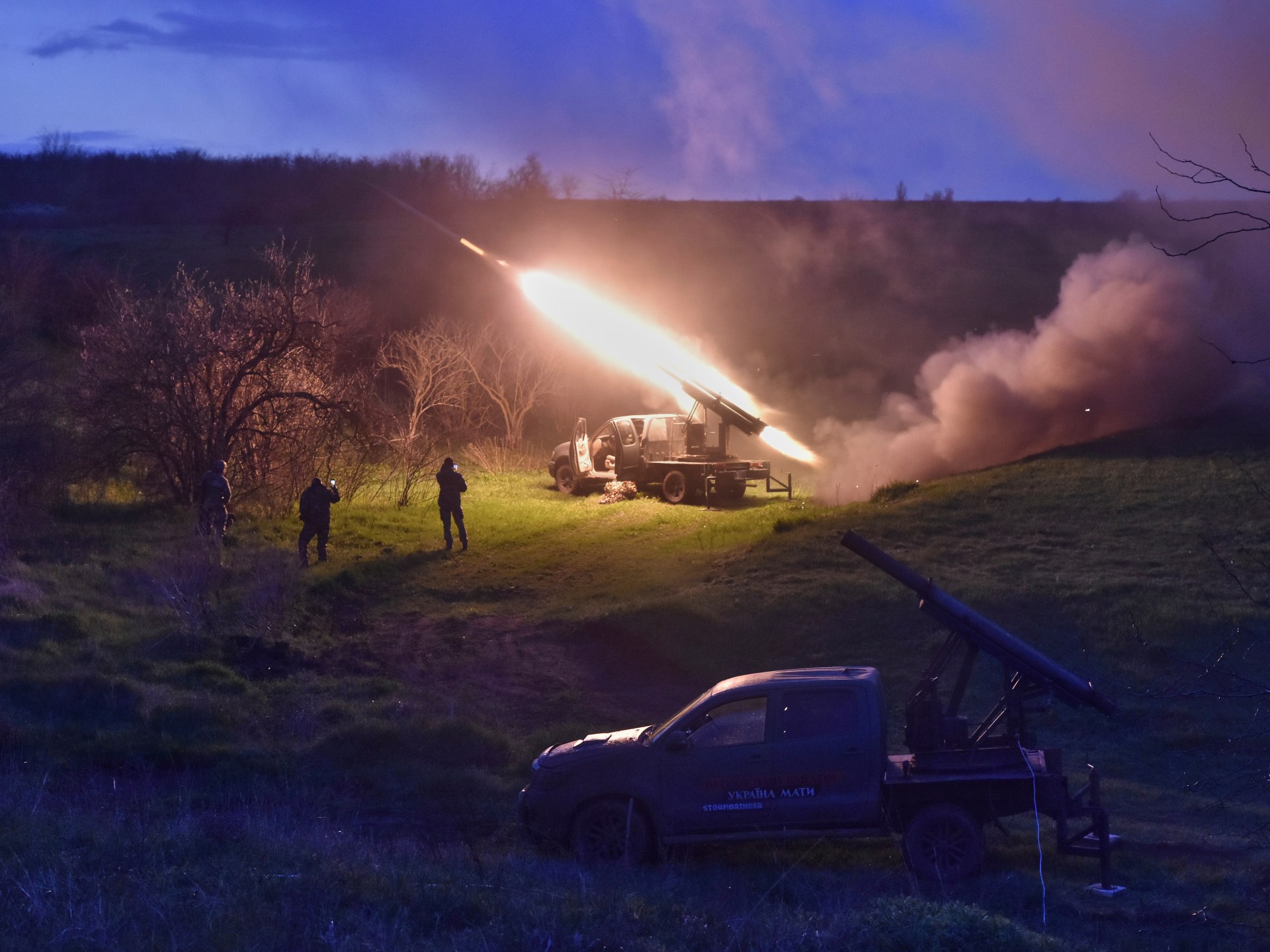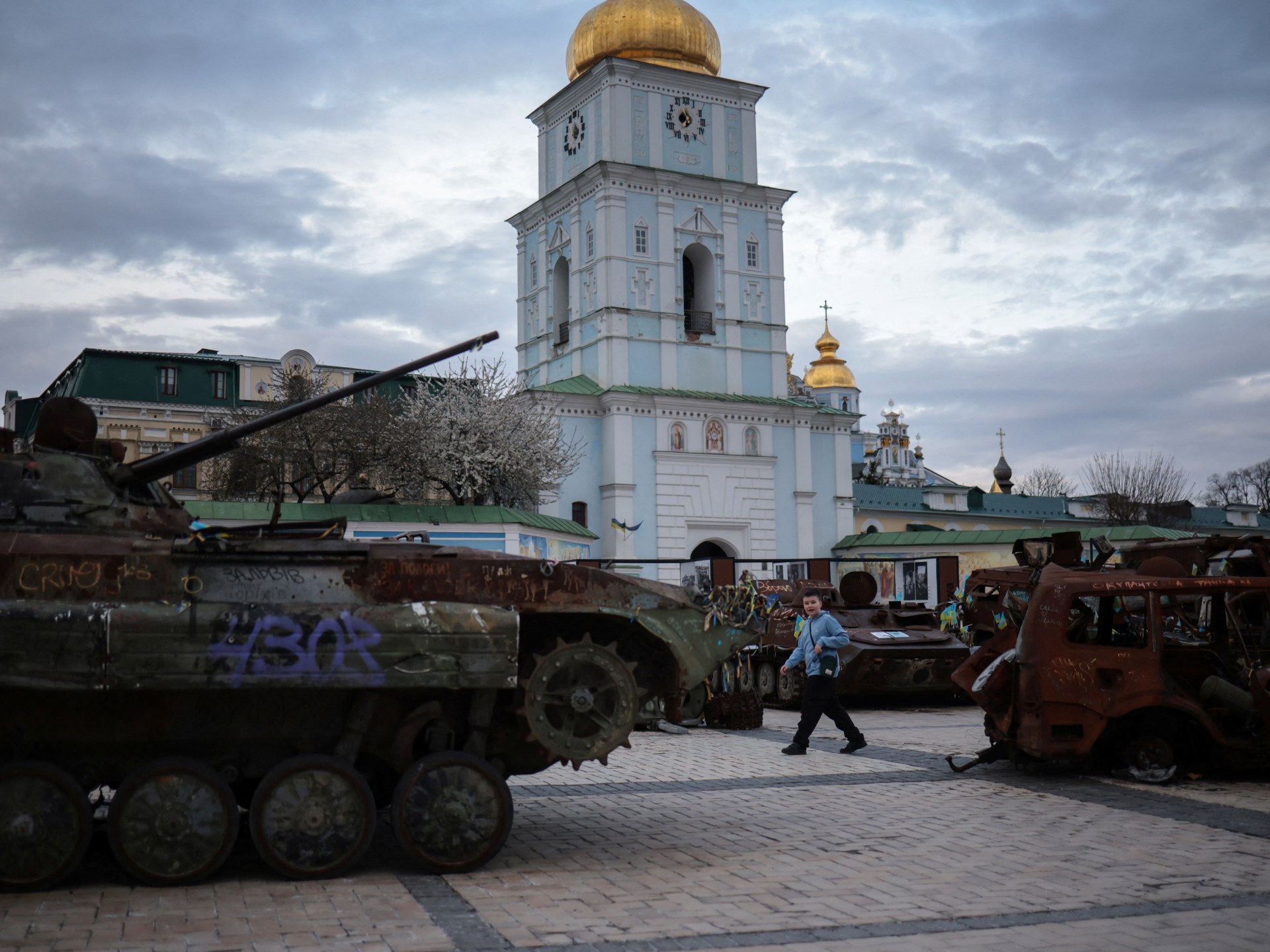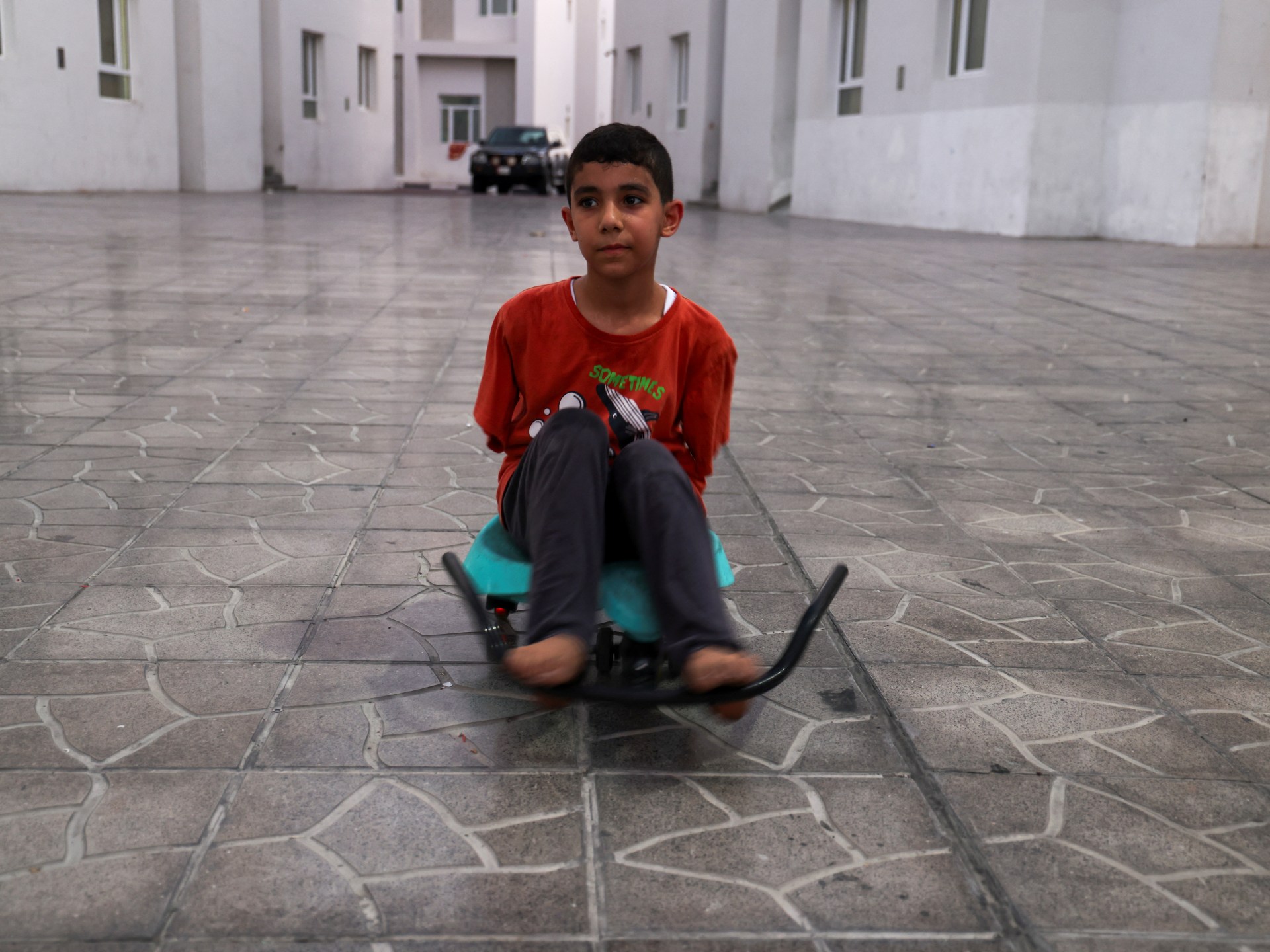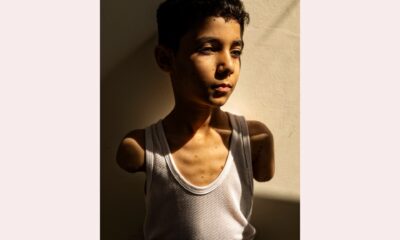Conflict Zones
Russian advances in Ukraine slow down despite growing force size | Russia-Ukraine war News

Russia’s territorial gains in Ukraine are slowing down dramatically, two analyses have found, continuing a pattern from 2024 at a time when both nations are trying to project strength in the face of United States-mediated negotiations aimed at ending the war.
Britain’s Ministry of Defence last week estimated that Russian forces seized 143sq km (55sq miles) of Ukrainian land in March, compared with 196sq km (76sq miles) in February and 326sq km (126sq miles) in January.
The Institute for the Study of War, a Washington, DC-based think tank, spotted the same trend, estimating Russian gains at 203sq km (78sq miles) in March, 354sq km (137sq miles) in February and 427sq km (165sq miles) in January.
These estimates are based on satellite imagery and geolocated open-source photography rather than claims by either side.
Should this trend continue, Russian forces could come to a standstill by early summer, roughly coinciding with US President Donald Trump’s self-imposed early deadline for achieving a ceasefire.
Russia’s diminishing returns have come even as it has greatly expanded the size of its forces from an estimated 150,000 soldiers who carried out its initial invasion in February to May 2022.
“Since the beginning of the aggression, the enemy has increased its group fivefold,” Ukrainian Commander-in-chief Oleksandr Syrskii told the online publication Livyi Bereg this week. He estimated that Russia has been adding 120,000 to 130,000 soldiers a year to its forces in Ukraine and it today has about 623,000 military personnel in the country.
Despite this, almost all of the Ukrainian territory Russia occupies, about a fifth of the country, was the result of the seizure of Crimea in 2014 and its initial, full-scale invasion in 2022.
A Ukrainian counteroffensive in 2023 took back about 20,000sq km (7,722sq miles). Russia has so far failed to recapture that.
Its grinding advances in Ukraine’s eastern region of Donetsk last year succeeded in wresting away just 4,168sq km (1,609sq miles) of fields and abandoned villages – equivalent to 0.69 percent of Ukraine, the Institute for the Study of War determined in January.
Those gains also came at a significant cost in men and materiel. Ukraine’s Ministry of Defence put Russia’s losses of soldiers at 430,790. That’s the equivalent of 36 Russian motorised rifle divisions and outnumbers Russia’s losses in 2022 and 2023 combined.
While Russia has recruited enough soldiers to more than make up for its losses, its performance on the battlefield suggests it is struggling to train and equip its forces.
Moscow’s announcement of each capture, however small, has helped create an impression of inevitability to its conquest of Ukraine. On Monday, for example, Russia’s Ministry of Defence said it had taken the settlement of Katerinovka in Donetsk.
But these conquests have been small. The Institute for the Study of War estimated that even at 2024 rates of advance, Russia would have needed two years to capture the remaining parts of Donetsk alone. And that was before Russia’s pace of territorial gains slipped further in 2025.
Escalation with negotiation
Despite these trends, Russian President Vladimir Putin has escalated his aggression since US-Russian ceasefire talks kicked off on February 18.
An analysis by The Telegraph found that the number of Russian drone strikes against Ukraine rose by more than 50 percent from January to February.
In the first week of March, Russia launched a concerted effort that mostly pushed Ukrainian soldiers out of Kursk, a Russian border region Ukraine invaded in August.
On April 9, Russia said only two settlements – Gornal and Oleshnya – remained in Ukrainian hands in Kursk, and it was locked in fierce battles to recapture them.
Russia’s March success in Kursk coincided with a US intelligence and military aid cut-off for Ukraine.
During the past week, Russia was building up forces to follow up its success in Kursk by opening new fronts in Kharkiv and Sumy, two regions in northeastern Ukraine on the border with Russia, Syrskii said.
“For several days, almost a week, we have been observing an almost doubling of the number of enemy offensive actions in all main directions,” he said.
Syrskii also said he believed Russia could use joint military exercises with Belarus planned for the autumn as cover to mobilise more forces, a tactic Moscow used in late 2021. “The visibility of exercises is the most acceptable way to rebase, transfer troops, concentrate in a certain direction and create a troop group,” Syrskii said.
No ceasefire
Moscow also went on the diplomatic offensive this week, doubling down on efforts to vilify Ukrainian President Volodymyr Zelenskyy as an unreliable leader.
Russian officials said Ukraine was continuing to defy a ceasefire on energy infrastructure Kyiv never agreed to but that Moscow declared unilaterally on March 18 after a phone call between Trump and Putin.
On Friday, Russia’s Defence Ministry said Ukraine carried out half a dozen attacks on energy facilities in the Bryansk, Tambov and Lipetsk regions, causing gas outages to three cities and two electricity blackouts.
“More than 100 Ukrainian unmanned aerial vehicles sent to bomb civilian targets on Russian soil in one night alone are a thousand times more telling than Zelensky’s wails about his ‘aspiration for peace’,” Russian special envoy Rodion Miroshnik wrote on his Telegram channel.
Kremlin spokesman Dmitry Peskov on Monday said ceasefire negotiations were complicated by the “lack of control over the Kyiv regime, about the impossibility of the Kyiv regime to control the actions of a number of extremist and nationalist units that simply do not obey Kyiv”. That was a reference to the alleged existence of far-right elements in the Ukraine military.
Russia and the US are expected to hold a round of negotiations in Istanbul on Thursday.
On Wednesday, Russia’s Defence Ministry said two drones were shot down while trying to strike the gas distribution plant of the city of Temryuk, which sits on a neck of land on the Russian side of the Crimean Peninsula.
That same night, the ministry said, eight Ukrainian drones were shot down before reaching the Korenovskaya electrical plant, which powers the TurkStream gas pipeline. Ukraine has twice this year tried to shut the pipeline down by targeting its compressors.
In total, Russia’s Defence Ministry said it had intercepted 107 Ukrainian drones over 10 regions on the night of April 3 to early April 4 in one of the biggest such attacks.
But Russia, too, targeted the Kherson thermal power plant with a short-range first-person view (FPV) drone on Friday, Zelenskyy said. FPV drones generally carry up to 5kg (11lb), a much smaller payload than long-range strike drones, which usually ranges from 20kg to 50kg (44lb to 110lb).
The Kremlin gave less publicity to the fact that a Ukrainian drone barrage on Saturday struck the fibre optic systems plant in Saransk in Russia’s Mordovia. It is Russia’s only plant manufacturing optical fibre used in FPV drones and other defence systems.
Russia also did not mention that Ukrainian drones struck industrial explosives manufacturer Promsintez in the Samara region, causing 20 explosions and fires. The plant reportedly stopped production after the attack.
Syrskii said in his interview that drones had destroyed a $100m long-range Tupolev-22M3 bomber days earlier. Ukraine has targeted these bombers because they are used to launch thousands of glide bombs against Ukraine’s front lines every month.
Syrskii also said strikes against Russian airfields had pushed back the Russian air force, reducing its effectiveness.
Unlike Ukraine, which has consistently targeted defence and energy infrastructure, Russia has kept up long-range air attacks targeting Ukrainian cities.
In retaliation for Saturday’s attacks, Russia launched 18 cruise missiles, six ballistic missiles and 109 attack drones on Saturday night – its largest strike in a month.
Ukraine said it intercepted 93 of the drones, one ballistic and 12 cruise missiles but five ballistic missiles struck residential areas.
One of them killed 20 people in Kryvyi Rih, including nine children, prompting the United Nations Security Council to hold an emergency meeting.
“This is why the war must end,” US Ambassador to Kyiv Bridget Brink wrote on social media.
“Such a strong country, such a strong people – and such a weak reaction,” Zelenskyy responded on Telegram. “They are even afraid to say the word ‘Russian’ when talking about the missile that killed children.”
Russia accused Zelenskyy of deliberately framing the attack as an indiscriminate massacre of civilians whereas it was really targeting a meeting of foreign mercenaries with Ukrainian commanders at a restaurant.
But Russia followed up the ballistic missile strike in Kryvyi Rih with a wave of drones, which hit a playground and residential buildings.
Until this strike, Russia and Ukraine had observed an unofficial ceasefire over the Black Sea. This had apparently come to an end because Zelenskyy said several of the Russian missiles were launched from ships and submarines.
The attacks continued this week. Russia’s Defence Ministry on Monday said it shot down 19 Ukrainian drones overnight.
Ukraine’s air force said it intercepted 31 drones on Tuesday out of an attack totalling 46. The drones followed a strike by an Iskander ballistic missile in a tactic reminiscent of that on Kryvyi Rih.
The following night, Russia launched 55 Shahed drones at Ukraine. Ukraine’s air force said it downed 32 and disoriented eight. Russia said it downed 158 Ukrainian drones over 11 regions.
After North Koreans, the Chinese
Ukraine’s 81st Separate Airmobile Sloboda Brigade on Tuesday said it captured two Chinese soldiers on Ukrainian soil.
Zelenskyy confirmed it at a news conference, saying, “Ukrainians engaged in combat with six Chinese service members in the Donetsk region – in Tarasivka and Bilohorivka.”
He later wrote on social media: “We have information suggesting that there are many more Chinese citizens in the occupier’s units.”
US Department of State spokesperson Tammy Bruce said Chinese soldiers’ involvement was “disturbing”.
Chinese Ministry of Foreign Affairs spokesperson Lin Jian on Wednesday denied Beijing’s involvement. But Russian television channels showed further evidence of Chinese troops in Ukraine weeks earlier.
Conflict Zones
Could an earthquake shift the balance in Myanmar’s civil war? | Military News
Bangkok, Thailand – As Myanmar slowly recovers from the magnitude 7.7 earthquake that killed thousands in March, an even greater catastrophe continues to shape the nation’s future – this one man-made.
Myanmar remains gripped by a civil war and after four years of fighting the military regime finds itself increasingly encircled.
But the impact of the earthquake could prove decisive for the conflict in the coming year.
Striking in Myanmar’s central Sagaing Region on March 28, the quake killed at least 3,649 people, with more than 5,000 injured and 145 still missing, according to figures from the military government.
The seismic shock flattened houses, factories, Buddhist pagodas, apartment blocks and brought down bridges and ripped up roads in Sagaing city and nearby Mandalay.
It also disrupted electricity supplies to factories producing munitions for the military, said Tin Lin Aung, a former major in Myanmar’s army who defected to the resistance movement in 2022.
In a clear sign that military supplies are stretched, bullet and artillery casings recently captured from government forces bear this year’s manufacturing date, Tin Lin Aung said.
“When I was in the military, we used to joke that some of the bullets were older than us,” he said.
“Now they are being used straight away,” he said.
The reported interruption to the military’s ammunition production comes as areas the army still controls in Myanmar are surrounded on almost all sides by longstanding ethnic armed groups and newer armed opposition forces.
Despite this, the military maintains an iron grip on the country’s major cities and core critical infrastructure.
Hemmed into urban strongholds, the military has tried to reverse its losses through indiscriminate air strikes and burning villages in rural areas – a campaign the United Nations suspects involves war crimes.

‘More momentum than the military’
Sagaing city was devastated by the quake and it remains under military control, while much of the surrounding countryside is governed by a patchwork of resistance militias – such as the People’s Defence Force (PDF) – which are loosely coordinated by the opposition National Unity Government (NUG).
The NUG declared a truce in earthquake-affected areas until April 20, except for “defensive operations”, yet the military’s operations have continued.
According to the NUG, the Myanmar military’s aerial and artillery attacks killed at least 72 civilians between the quake striking on March 28 until April 8. Two more civilians, including a 13-year-old girl, died from bombing by military aircraft on April 10, the Myanmar Now news outlet reports.
A Sagaing-based PDF fighter who requested anonymity said some rebel units had pivoted to relief efforts in central Myanmar even though their military adversaries were taking advantage of the lull in battle.
“Since the quake, the military has used the Sagaing-Monywa road more confidently because of the truce,” she said. But PDF forces in Sagaing expect fighting to intensify after the April truce is over.
“The PDF has more momentum than the military here,” she told Al Jazeera, adding that the NUG is now “coordinating better with ethnic armed organisations”.
“There will be more fighting in coming months,” said Ko Ko Gyi of the Sagaing PDF’s Battalion 3.
Regional security analyst Anthony Davis said he doubted the earthquake would distract the military from its strategic objectives, adding that most soldiers had stayed in their garrisons rather than help with relief efforts.
“The military isn’t taking time off to save people. They’ll keep up the air strikes and, where possible, launch ground offensives to weaken the PDF,” Davis said.
But it is western Rakhine State – largely spared from the earthquake – that is still the most consequential battleground currently, he said.
There, the rebel Arakan Army (AA) has clashed with the military’s forces around the state capital Sittwe and Kyaukphyu, the site of a key pipeline that transports gas from across Myanmar to China.
The AA has simultaneously pushed out of its home territory in the west of the country and into Myanmar’s central heartlands in Magwe, Bago and Ayeyarwady regions, Davis said.
“They are the swing player who can significantly move this conflict one way or another,” he added.
Commanding an estimated 40,000 soldiers, the AA has a proven record of defeating the military regime’s forces.
In eastern Myanmar’s Kayah State, a senior resistance commander said the earthquake had underscored the suffering of displaced communities who “bear the brunt of the ongoing wars”.
“The side who’s willing to care for the people can sway public opinion and will succeed in the coming battles,” he said.
In the north and northwest, the military is on the back foot.
The Kachin Independence Army captured Indaw town in the northern Sagaing Region on April 7 after an eight-month siege, despite declaring its own post-quake truce. Chin resistance forces recently gained control of Falam township in western Myanmar – though they had not announced any ceasefire.
Political analyst Kyaw Hsan Hlaing said the military is still grappling with the aftermath of the earthquake and that may create openings for the AA and others to seize more towns.
“However, any such gains would likely be incremental, as the military’s longstanding control and ability to adapt, especially in regions like Bago and Magwe, even under crisis conditions remain significant,” he said.
“In the long term, the earthquake is unlikely to fundamentally shift the balance of power in Myanmar,” he said.
‘Divine intervention’
While the earthquake has not dealt a decisive blow to military rule, the quake has delivered a psychic shock to the regime’s generals.
In a country where astrology and superstition guide the highest political decisions, many interpret the natural disaster as a cosmic rebuke against Myanmar’s military leadership.
“They see this earthquake as divine intervention – punishment for the mistakes of the king. From what I hear, they are not blaming him [regime leader Min Aung Hlaing] directly. But there are questions about his leadership and capacity,” said former major Tin Lin Aung, who still maintains contacts within the secretive military establishment.
According to Tin Lin Aung, the regime has ordered civil servants nationwide to recite a protective Buddhist chant nine times daily for nine consecutive days. The number nine has auspicious symbolism in Buddhist tradition.
He also described growing confusion within the ranks over the regime’s response to the earthquake – appealing for international aid and assistance, declaring a truce, while also continuing its attacks.
“They know the people hate them more and more, and their leader seems lost,” he said.
Richard Horsey, senior Myanmar adviser at the International Crisis Group, said even if Myanmar military’s commander-in-chief Senior General Min Aung Hlaing dismisses these supernatural interpretations, the fact that his inner circle takes them seriously creates real vulnerability. Instead of causing an internal coup, he suggested the quake as a bad omen would more likely signal the erosion of Min Aung Hlaing’s authority and the rise of open criticism.
“You go from there to people feeling they can just ignore his orders and do their own thing because everyone else agrees with them, not him,” he said.
Political analyst Kyaw Hsan Hlaing said some sources suggest that beliefs in the quake as a portent of collapse for military rule may be used to push the narrative that the regime needs to “act decisively to regain control”.
Superstition is just one of many factors shaping the military’s decisions in the conflict, he added.
The earthquake has also “done enormous damage to the basic fabric of Myanmar,” Horsey said, noting that Mandalay’s residents are potentially facing relocation due to extensive housing damage.
Given the scale of the quake, it would likely affect the civil war – “but in ways that are hard to predict”, he said.

Criticised for its ineffectual and disinterested response to earthquake victims, along with continued attacks at a time of national emergency, the military’s poor reputation has plummeted even further in the eyes of the people and its adversaries.
The powerful ethnic armed groups involved in the conflict will probably be even more unwilling to negotiate for peace with the military following the quake, Horsey said.
“Even if you could get a spirit of compromise, which seems not to exist”, few would believe the military’s sincerity in adhering to any peace deal or ceasefire document.
“Who would believe that piece of paper,” Horsey said, when it is signed by a military that is considered “so illegitimate and so incompetent.”
Conflict Zones
Trump says US may ‘pass’ on helping end war if Russia, Ukraine resist deal | Russia-Ukraine war News

President Donald Trump says the United States will “take a pass” on trying to resolve the Russia-Ukraine war if either Moscow or Kyiv makes it too difficult to end the conflict.
Trump was speaking after US Secretary of State Marco Rubio commented – following talks with European allies in Paris – that Washington would “move on” if a truce did not seem “doable” within days.
The US president refused on Friday to cast blame on either Russian President Vladimir Putin, who ordered the February 2022 full-scale invasion of pro-Western Ukraine, or Ukrainian President Volodymyr Zelenskyy. But he insisted both sides had to make progress.
“Now, if, for some reason, one of the two parties makes it very difficult, we’re just going to say: ‘You’re foolish. You’re fools. You’re horrible people’ – and we’re going to just take a pass,” Trump said.
“But, hopefully, we won’t have to do that.”
Rubio further suggested on Friday that Trump’s patience towards the negotiations is running thin.
“If it’s not possible, if we’re so far apart that this is not going to happen, then I think the president is probably at a point where he’s going to say, ‘Well, we’re done,’” he said.
Trump told reporters on Friday, however, that he did not want to say he was walking away from the talks. He said he still believes there is a good chance to end the conflict.
“It’s coming to a head right now,” he said.
US Vice President JD Vance also said he was “optimistic” a resolution could be reached, while speaking on a trip to Rome.
‘Trying to help’
Ukraine has agreed to a full temporary ceasefire and accused Russia of stalling on a deal to get a better negotiating position.
Putin last month rejected a joint US-Ukrainian proposal for a full and unconditional pause in the conflict, while the Kremlin has made a truce in the Black Sea conditional on the West lifting certain sanctions.
When asked if Putin was stalling, Trump, who held direct talks with the Russian leader in February, said: “I hope not … I’ll let you know soon.”
Trump also denied he was being “played” by the former KGB agent, who denied Russia was going to invade right up until the eve of the attack.
“Nobody’s playing me, I’m trying to help,” Trump said.
Russia’s Foreign Minister Sergey Lavrov said in an interview with the Kommersant newspaper published on Monday that it is “not easy” to agree on “key components” of a peace deal.
He did, however, concede that the Trump administration is trying to understand the “root cause” of the conflict, which he said was triggered by “the actions of Washington and Brussels” in having “brought the current regime to power in Ukraine”.
Fighting continues
Amid ceasefire negotiations, on the front line on Friday, a Russian missile strike killed one person in the northeastern Ukrainian city of Kharkiv, with a separate drone attack killing another person in the nearby city of Sumy.
At least five children were among dozens of people injured in Friday morning’s attack on Kharkiv that damaged 15 residential buildings, a business and an educational facility, according to Kharkiv Mayor Ihor Terekhov and emergency services.
Reporting from Kyiv, Al Jazeera’s Zein Basravi said Russia also targeted Lviv, Dnipro, Mykolaiv and Kyiv.
“We saw multiple missile, drone, artillery and rocket attacks in cities across the country about 5am local time when curfews come to a close and people begin their daily lives,” he said.
“[In Kharkiv], civilian infrastructure was damaged, one person was killed, and 74 were injured. Of the 74, five were children,” Basravi reported.
President Zelenskyy said on Thursday that although Russia had seemingly scaled back its targeting of energy infrastructure, the overall volume of missile and drone attacks remained unchanged. It is striking Ukraine’s civilian sites instead, he added.
Russia has said it had hit “key drone production sites” and Ukrainian military airfields.
Moscow also warned on Friday of potential escalation if Germany proceeds with plans to send Taurus long-range missiles to Ukraine. Speaking at the United Nations on Thursday, Russia’s ambassador, Vassily Nebenzia, declared that such a move would mark Germany’s direct entry into the war.
“These countries are waging a war against Russia using their proxy forces,” he said. “Delivering Taurus missiles would be another step toward escalation.”
Conflict Zones
‘How do I live like this?’ asks Gaza boy who lost arms in Israeli attack | Gaza News

An image of Mahmoud Ajjour, 9, who was severely wounded in an Israeli strike, won the 2025 World Press Photo of the Year award.
A Palestinian child who was severely wounded in an Israeli drone attack on Gaza last year, and who was pictured in an image that won the 2025 World Press Photo of the Year award, says he has been struggling to adapt to life since losing both his arms in the explosion.
Speaking to Al Jazeera from Doha, Qatar, where he has been receiving treatment, nine-year-old Mahmoud Ajjour recalled the moment the bomb exploded, targeting his home in March 2024.
At first, Ajjour, who hails from Gaza City’s old town, said he did not realise he was wounded.
“I thought I had simply fallen. But I found myself on the ground, exhausted, and wondering what had happened,” he told Al Jazeera.
In reality, one arm “flew off, and one flew and fell right beside me”, he added.
Still unaware that he had sustained serious wounds – wounds that mutilated his entire body – Ajjour said he looked around and saw his arms. Although they looked familiar, his brain still could not comprehend that they had been blown off.
“My mother then told me that I lost my arms,” Ajjour recalled. “I started crying. I was very sad, and my mental state was very bad.”
His mental health deteriorated further when he, like many others in Gaza, had to undergo surgery without anaesthetics due to a severe lack of medical supplies. Throughout the war, Israeli forces have largely kept vital border crossings shut, preventing the entry of much-needed medical supplies, as well as food and other aid, including fuel.
“They performed surgery on me while I was awake,” Ajjour said, the shock still evident in his voice.
“I couldn’t bear the pain, I was screaming very loud. My voice filled the hallways.”
‘Everything is difficult’
Ajjour is one of thousands of children in Gaza who are suffering life-changing injuries due to relentless, indiscriminate Israeli bombardment.
According to the United Nations Children’s Fund, more than 10 children each day have lost one or both of their legs since October 7, 2023, when Israel launched its ongoing genocide in Gaza.
That is more than 1,000 children.
“Gaza now has the highest number of children amputees per capita anywhere in the world – many losing limbs and undergoing surgeries without even anaesthesia,” UN Secretary-General Antonio Guterres said in December.
Ajjour is now learning to write, play games on his phone, and dress himself using his feet – but still needs special assistance for most daily activities.

He now longs for the days when his arms were still intact.
Before the attack, Ajjour said he used to go to the market and buy his mother vegetables and food she needed.
“Now, everything is difficult, including feeding myself, helping myself to the bathroom … but I try my best,” he said. “I manage my life like this. I make it work.”
Ajjour dreams of a future where he can return to Gaza and help rebuild the devastated enclave.
He hopes the world can “end the war on Gaza”.
“We want to live on our land. We don’t want the Israelis to take it,” he said.
“People are dying there [in Gaza]. And my home was bombed. How could I live like this?”
Israel’s ongoing assault on the besieged and bombarded territory has so far killed more than 51,000 Palestinians and wounded at least 116,505 others, according to Gaza’s Ministry of Health.
It has also forcibly displaced most of its 2.3 million strong population, ravaged most of the land, damaged basic infrastructure and dismantled its already-struggling healthcare system.
-

 Conflict Zones2 days ago
Conflict Zones2 days agoHaiti in ‘free fall’ as violence escalates, rights group warns | Armed Groups News
-

 Middle East2 days ago
Middle East2 days agoPalestinian photographer Samar Abu Elouf wins world’s top photo prize | Gaza News
-

 Africa2 days ago
Africa2 days agoEuropean Union announces new asylum measures
-

 Sports2 days ago
Sports2 days agoJu Wenjun: Chinese grandmaster makes history by winning fifth Women’s World Chess Championship
-

 Middle East2 days ago
Middle East2 days agoHamas accuses Israel of weaponising aid as Gaza’s hunger crisis worsens | Gaza News
-

 Lifestyle2 days ago
Lifestyle2 days agoPicking a team from bars to beam and hoping for 10s: Fantasy leagues in gymnastics are a thing
-

 Middle East2 days ago
Middle East2 days agoPortrait of amputee Palestinian boy from Gaza wins World Press Photo award | Israel-Palestine conflict News
-

 Sports2 days ago
Sports2 days agoArsenal reaches first Champions League semifinal in 16 years, with Inter Milan also advancing



